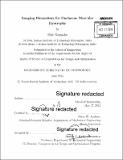Imaging biomarkers for Duchenne muscular dystrophy
Author(s)
Koppaka, Sisir
DownloadFull printable version (6.818Mb)
Alternative title
Imaging biomarkers for DMD
Other Contributors
Massachusetts Institute of Technology. Computation for Design and Optimization Program.
Advisor
Brian W. Anthony.
Terms of use
Metadata
Show full item recordAbstract
Duchenne muscular dystrophy (DMD) is the most common muscular dystrophy of childhood and affects 1 in 3600 male births. The disease is caused by mutations in the dystrophin gene leading to progressive muscle weakness which ultimately results in death due to respiratory and cardiac failure. Accurate, practical, and painless tests to diagnose DMD and measure disease progression are needed in order to test the effectiveness of new therapies. Current clinical outcome measures such as the sixminute walk test and North Star Ambulatory Assessment (NSAA) can be subjective and limited by the patient's degree of effort and cannot be accurately performed in the very young or severely affected older patients. We propose the use of image-based biomarkers with suitable machine learning algorithms instead. We find that force-controlled (precise acquisition at a certain force) and force-correlated (acquisition over a force sweep) ultrasound helps to reduce variability in the imaging process. We show that there is a high degree of inter-operator and intra-operator reliability with this integrated hardware-software setup. We also discuss how other imaging biomarkers, segmentation algorithms to target specific subregions, and better machine learning techniques may provide a boost to the performance reported. Optimizing the ultrasound image acquisition process by maximizing the peak discriminatory power of the images vis-à-vis force applied at the contact force is also discussed. The techniques presented here have the potential for providing a reliable and non-invasive method to discriminate, and eventually track the progression of DMD in patients.
Description
Thesis: S.M., Massachusetts Institute of Technology, School of Engineering, Center for Computational Engineering, Computation for Design and Optimization Program, 2015. Cataloged from PDF version of thesis. Includes bibliographical references (pages 75-78).
Date issued
2015Department
Massachusetts Institute of Technology. Computation for Design and Optimization ProgramPublisher
Massachusetts Institute of Technology
Keywords
Computation for Design and Optimization Program.